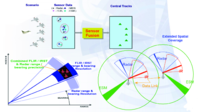
Photo from wikipedia
Joint source and sensor localization (JSSL) attempts to simultaneously locate the multiple sources and sensors by exploiting the measurements between them. The research of JSSL has been based on time… Click to show full abstract
Joint source and sensor localization (JSSL) attempts to simultaneously locate the multiple sources and sensors by exploiting the measurements between them. The research of JSSL has been based on time of arrival (TOA) measurements that require synchronization of the sources and sensors. This paper explores the use of angle of arrival (AOA) observations instead for the JSSL problem that does not require synchronization. The investigation and development presented are valid for localization in a $d\geq 2$ dimensional space. We first look into the feasibility and the fundamental properties of JSSL using AOA in terms of localization ambiguity, the minimal source and sensor case and the Cramér-Rao lower bound (CRLB). By representing the AOA as the direction vector of arrival (DVOA), we next devise the rank property of DVOA matrix for the JSSL problem. The rank property leads us to develop the algorithms for the refinement of AOA observations, the estimation of TOAs between the sources and sensors and the closed-form solution of their positions. The optimality of the closed-form solution in reaching the global minimum of the cost function based on DVOA is established. Simulations confirm the theoretical developments, and support the performance of the proposed JSSL solution in reaching the CRLB accuracy under Gaussian noise when the number of sources and sensors is sufficient.
Journal Title: IEEE Transactions on Signal Processing
Year Published: 2020
Link to full text (if available)
Share on Social Media: Sign Up to like & get
recommendations!